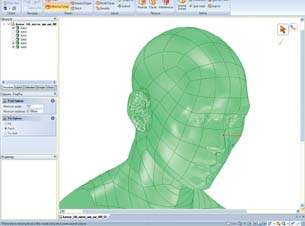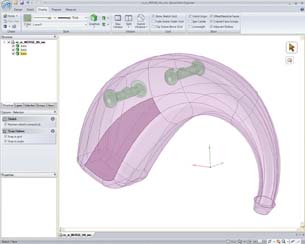November 1, 2009
By DE Editors
 Figure 1. CAD drawing of the Inteo IN-m hearing aid, including details of the microphone inlets |
Each design application has its own particular demands and requires a special combination of tools to achieve excellence. The optimization of hearing aid designs calls for a unique skill set—the ability to perform basic functions in one area but extensive expertise and creativity in others. This is the case with Widex, a leading provider of digital hearing aid technology.
Constant review and evaluation of designs and approaches requires simplifying CAD designs, analyzing acoustics and vibration, and using a specialized algorithm-development and simulation environment. To meet these needs, the hearing aid technology developer assembled a collection of tools that provided flexible and easy-to-use interfaces, interoperability, and specific technical functionality. This software mix streamlined development processes, reduced cycle time, and optimized the use of resources.
Finding the Right Tools for the Job
Hearing aid developer Widex infuses expertise and creativity in the advancement of these electroacoustic devices and ensures high performance through rigorous analysis, enabled by 3D direct modeling.
The American Academy of Audiology estimates that 36 million Americans require hearing aids, and as the Baby Boomer generation grows older, the number of people with hearing impairment and loss increases rapidly. As a result, the need for quality products that help individuals overcome these physical problems has never been higher, and companies such as Widex are investing the time and effort required to perfect the technology.
The 3D Design Challenge
Mads Jakob Jensen is a development engineer who has been working with Widex for more than three years. His primary function is to develop and improve hearing aid designs. With most behind the ear (BTE) models, the electronics on the outside of the ear connect to a mold on the inside via a tube. Inevitably, a small amount of sound leaks out around the mold, reducing the sound transmitted to the eardrum and potentially interfering with the exterior microphone, causing grating sounds for the user.
“My job is to analyze current models and newer designs to determine what has worked well and what needs improvement,” says Jensen.
Jensen uses COMSOL primarily to analyze acoustics and vibrations to optimize hearing aid performance. As part of the process of preparing the model for analysis, he must simplify the existing design, which is sent to him in one of the many CAD formats. Jensen is not a CAD expert, and when he received the existing designs, he had to send them to the design department to be de-featured and simplified so that he could perform what-if analyses. This process was time consuming and resulted in lengthy and frustrating delays before he could proceed. In some cases, CAD compatibility issues hindered his ability to complete the analysis.
 Figure 2. The Widex Inteo IN-m hearing aid on the ear of the KEMAR manikin |
Model Preparation
Jensen chose SpaceClaim 3D Direct Modeling software to reduce the time required to analyze single geometries. Despite his limited CAD-training, Jensen can perform all the necessary design and prep work with these models because of the software’s flexible and easy-to-use interface. With SpaceClaim, he can bypass the design department, streamlining the process and reducing cycle time.
Jensen now spends more time analyzing and improving hearing aid designs and less time preparing and transitioning, enabling him to focus his skills and creativity on the task at hand. More time is spent evaluating the advantages and opportunities to improve each hearing aid model and less time waiting for the models to go through CAD systems to be prepared for analysis.
“Before I started using SpaceClaim, I had to depend on other people to be sure I got my job done, now I can do it all myself,” says Jensen. “Often I had models for analysis we couldn’t get to at all because it took forever. Now, I am saving at least 10 work hours per model analyzed, and I am able to get results more quickly than I had anticipated.”
COMSOL and SpaceClaim
Once the model is prepared in SpaceClaim and ready for analysis, Jensen uses COMSOL Multiphysics’ PDE mode and transfers the results to a specialized simulation and algorithm-development environment that Widex assembled and built on MATLAB. The equations used in these studies are not standard in most commercial simulation software, but they integrate with COMSOL Multiphysics to enable Jensen to study the acoustic model of the ear and optimize the design of the hearing aid. The algorithms permit optimization of everything from the location of the microphones on each hearing aid to the location of miniature vents that reduce low-frequency sound at the eardrum.
“Our work is based mostly on thermoviscous acoustics, which is composed of numerous equations not commonly found in simulation software. Because COMSOL Multiphysics enables us to input our own equations, it has been essential to our studies,” says Jensen.
Prior to using COMSOL, the algorithms used for these procedures were based on experimental measurements gathered from lab tests that didn’t capture all the complexities required to adequately analyze the hearing aids. COMSOL enables Jensen to study more details that are difficult to acquire experimentally, including radiation from the ear mold and internal structural vibrations.
All this development leads to the ultimate goal of creating the most efficient device to help people enjoy and fully use their sense of hearing. SpaceClaim perfectly complements COMSOL to prepare models for performance-intensive analyses. Jensen is able to ready models quickly without getting bogged down in the complexity and compatibility issues inherent with traditional CAD systems. After performing analysis and design edits, he is able to provide a final model that specifies the detailed design in CAD, eliminating the time-consuming back-and-forth processes and expediting time to market.
Subscribe to our FREE magazine, FREE email newsletters or both!
About the Author
DE’s editors contribute news and new product announcements to Digital Engineering.
Press releases may be sent to them via [email protected].






